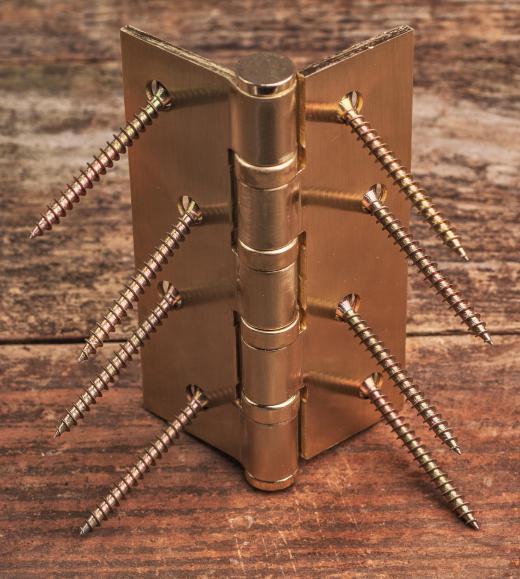A flag hinge is a piece of hardware used to allow movement of two pieces of material. They are commonly used on various types of doors to facilitate directional movement; the flag hinge itself is usually mounted on a vertical plane, thereby allowing horizontal movement of a door or other piece of material. The hinge consists of two parts: a male end with a plate and a pin, and a female end with a plate and a receiving slot. The two parts are joined together once each plate is secured to a different piece of material.
The male end, for example, may be secured to the door itself, while the female end of the flag hinge may be secured to a door frame. The hinge plates feature holes through which screws can be placed and drilled into the wood of the door or the frame. Once secured, the male end, which is typically mounted on the door, can be dropped into the receiving slot of the female end. The flag hinge then allows movement of the door. Most doors will feature two or three hinges to ensure stability and smooth movement. Other applications may only require one hinge, or far more than two or three.

The flag hinge is usually made from metal for durability, though other materials can be used for lighter duty applications. Some plastics, for example, can be suitable for lighter doors or lightweight applications, though this is less common than a metal hinge assembly. The flag hinge design has a distinct advantage over other types of hinges, since the design facilitates easy removal of the door. These hinges are most suitable for doors that are removed frequently, since the male end is not secured in the female end in any other way than by simple gravity.
The name of the flag hinge comes from the distinct look of the male end. The post and plate resemble the look of a flag on a flagpole. The size of the post and the plate can vary depending on the intended application of the hinge; larger posts and plates are usually capable of holding more weight, such as from larger doors, while narrower plates and smaller pins may only be suitable for smaller doors or lighter duty applications. The thickness of the plate can also have an effect on the hinge's weight capacity and overall durability, as can the thickness of the post.
